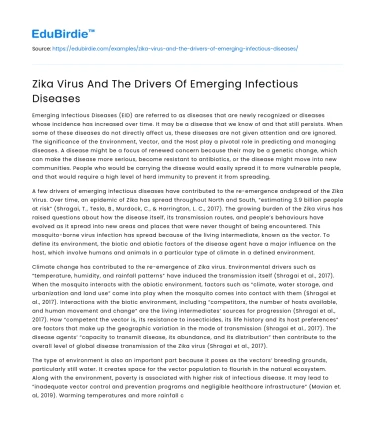Emerging Infectious Diseases (EID) are referred to as diseases that are newly recognized or diseases whose incidence has increased over time. It may be a disease that we know of and that still persists. When some of these diseases do not directly affect us, these diseases are not given attention and are ignored. The significance of the Environment, Vector, and the Host play a pivotal role in predicting and managing diseases. A disease might be a focus of renewed concern because their may be a genetic change, which can make the disease more serious, become resistant to antibiotics, or the disease might move into new communities. People who would be carrying the disease would easily spread it to more vulnerable people, and that would require a high level of herd immunity to prevent it from spreading.
A few drivers of emerging infectious diseases have contributed to the re-emergence andspread of the Zika Virus. Over time, an epidemic of Zika has spread throughout North and South, “estimating 3.9 billion people at risk” (Shragai, T., Tesla, B., Murdock, C., & Harrington, L. C., 2017). The growing burden of the Zika virus has raised questions about how the disease itself, its transmission routes, and people’s behaviours have evolved as it spread into new areas and places that were never thought of being encountered. This mosquito-borne virus infection has spread because of the living intermediate, known as the vector. To define its environment, the biotic and abiotic factors of the disease agent have a major influence on the host, which involve humans and animals in a particular type of climate in a defined environment.
Save your time!
We can take care of your essay
- Proper editing and formatting
- Free revision, title page, and bibliography
- Flexible prices and money-back guarantee
Climate change has contributed to the re-emergence of Zika virus. Environmental drivers such as “temperature, humidity, and rainfall patterns” have induced the transmission itself (Shragai et al., 2017). When the mosquito interacts with the abiotic environment, factors such as “climate, water storage, and urbanization and land use” come into play when the mosquito comes into contact with them (Shragai et al., 2017). Interactions with the biotic environment, including “competitors, the number of hosts available, and human movement and change” are the living intermediates’ sources for progression (Shragai et al., 2017). How “competent the vector is, its resistance to insecticides, its life history and its host preferences” are factors that make up the geographic variation in the mode of transmission (Shragai et al., 2017). The disease agents’ “capacity to transmit disease, its abundance, and its distribution” then contribute to the overall level of global disease transmission of the Zika virus (Shragai et al., 2017).
The type of environment is also an important part because it poses as the vectors’ breeding grounds, particularly still water. It creates space for the vector population to flourish in the natural ecosystem. Along with the environment, poverty is associated with higher risk of infectious disease. It may lead to “inadequate vector control and prevention programs and negligible healthcare infrastructure” (Mavian et. al, 2019). Warming temperatures and more rainfall contribute to the re-emergence of the Zika virus because the vector can easily adapt to its surroundings and produce in high amounts in warmers temperatures. This is a result of climate change and global warming. Human demographics and behaviour is another driver that contributes to the re-emergence of the Zika virus. The movement of humans throughout history has introduced certain species into certain populations. Activities such as “deforestation due to human settlement and agriculture, involving irrigation” affect the transmission and increased production of mosquitos (Mavian et. al, 2019).
It also all depends on the size of the population, meaning the larger and denser the population is, the faster the Zika virus can spread. Tropical islands in the Pacific and Indian Ocean inhibit a tropical climate, with hot and humid weather, abundant rainfall, and a wet and dry season, therefore mosquitos are more likely able to develop and adapt to their surroundings in this particular climate and weather. As the Zika virus’ “incubation period is 3-12 days”, it is an “epidemic in the Caribbean, Central and South America” (Poulakou & Plachouras, 2016). Characteristics of the Zika virus, particularly people at risk, include travelers and residents. There had been a reported “sexual transmission of the Zika virus around June 14, 2016 in central america” (Poulakou & Plachouras, 2016).
Bibliography
- Mavian, C., Dulcey, M., Munoz, O., Salemi, M., Vittor, A. Y., & Capua, I. (2019). Islands as Hotspots for Emerging Mosquito-Borne Viruses: A One-Health Perspective. Viruses (1999-4915), 11(1), 11. Retrieved from https://doi-org.ezproxy.langara.bc.ca/10.3390/v11010011
- Poulakou, G., & Plachouras, D. (2016). Planet’s population on the move, infections on the rise. Intensive Care Medicine, 42(12), 2055. Retrieved from https://eds-b-ebscohost-com.ezproxy.langara.bc.ca/eds/pdfviewer/pdfviewer?vid=0&sid=cfe49a49-1a48-4610-b9c3-87b53721656f%40sessionmgr120
- Shragai, T., Tesla, B., Murdock, C., & Harrington, L. C. (2017). Zika and chikungunya: mosquito-borne viruses in a changing world. Annals Of The New York Academy Of Sciences, 1399(1), 61–77. Retrieved from https://doi-org.ezproxy.langara.bc.ca/10.1111/nyas.13306 https://doi-org.ezproxy.langara.bc.ca/10.3390/v11010011
- https://eds-b-ebscohost-com.ezproxy.langara.bc.ca/eds/pdfviewer/pdfviewer?vid=0&sid=cfe49a49-1a48-4610-b9c3-87b53721656f%40sessionmgr120
- https://eds-b-ebscohost-com.ezproxy.langara.bc.ca/eds/pdfviewer/pdfviewer?vid=0&sid=cfe49a49-1a48-4610-b9c3-87b53721656f%40sessionmgr120
- https://doi-org.ezproxy.langara.bc.ca/10.1111/nyas.13306






 Stuck on your essay?
Stuck on your essay?

